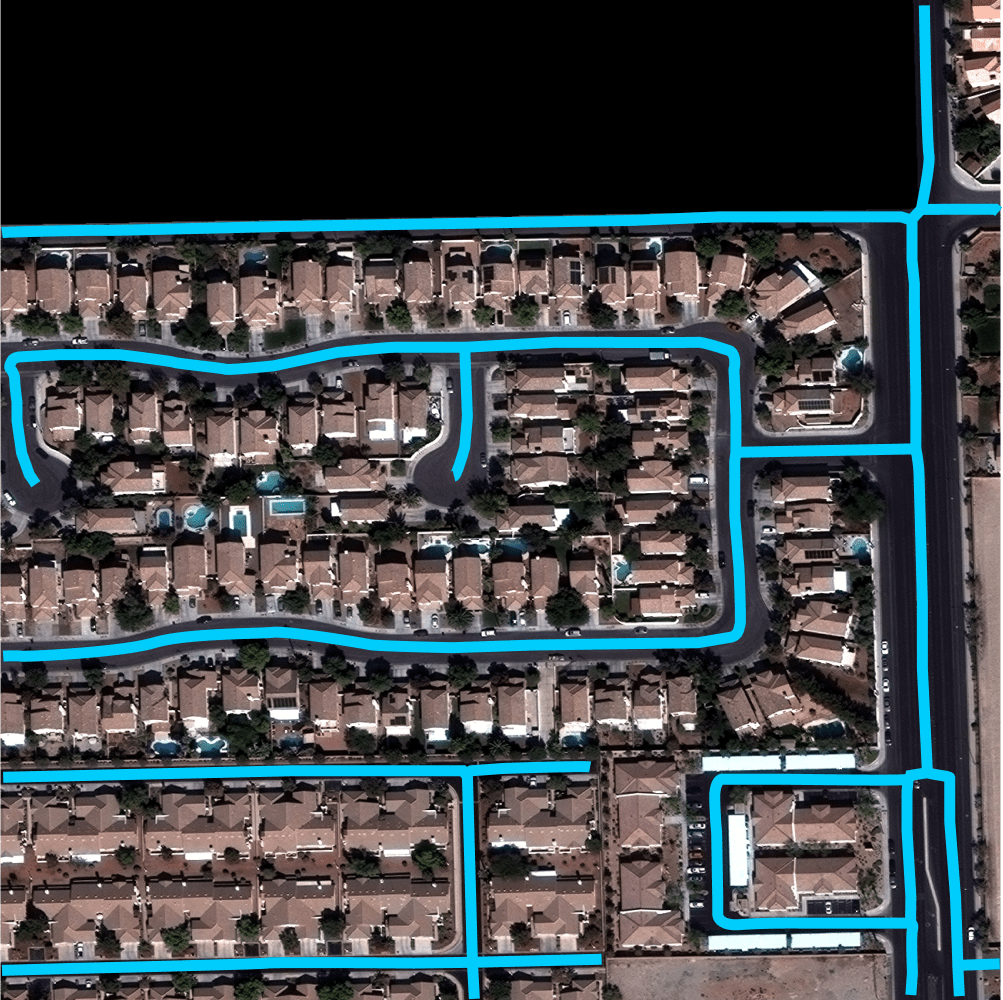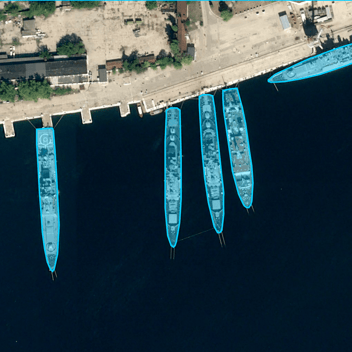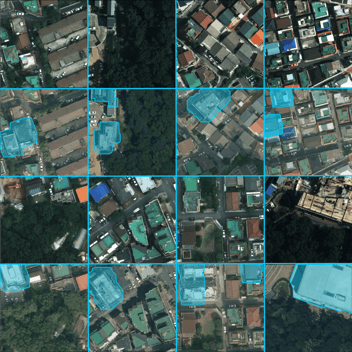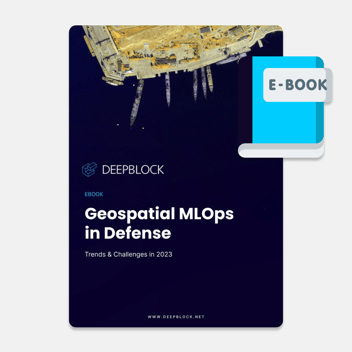Deep Block releases line segmentation for remote sensing imagery.

Deep Block just released its state-of-the-art line segmentation model, which is available on demand, contact sales to enable it.
Line segmentation is a pre-trained computer vision image segmentation model available on the Deep Block platform. It can be used out of the box to extract linear features from remote sensing imagery, enabling the automatic and accurate detection and delineation of roads, railway tracks, building edges, cables, and natural boundaries.

Example of Line segmentation use in remote sensing imagery of a neighborhood. On the left, the original image. In the middle, the result of the inference with the segmented line mask. On the right, both the original image and inference combined.
Line segmentation: a new weapon for IMINT analysts.
Victory in modern warfare hinges on the ability to cripple the enemy's supply network. The recent conflict in Ukraine highlights the limited access of planes, boats, and trains to strategic areas. As a result, road networks have emerged as a vital component of the war supply effort, providing the means to transport resources via cars and trucks. Both sides now prioritize maintaining and strengthening road networks. Notably, the Russian military has been building and repairing roads and fortifying bridges along the border with Ukraine, enabling the rapid and efficient transport of supplies. Meanwhile, the Ukrainians struggle to repair damaged infrastructure, when they are not entirely turned into active battlefields, giving the Russians a significant advantage.
That is when AI models such as line segmentation can play a crucial strategic role, especially in the realm of Image Intelligence (IMINT). IMINT is a subset of Geospatial Intelligence (GEOINT) that focuses on analyzing remote sensing imagery to provide more detailed information on an area’s geographic features and the activities of individuals, organizations, and foreign military forces.
Line segmentation algorithms enable IMINT analysts to accurately identify in satellite imagery other nations’ networks and infrastructures and analyze change over time. For example, this can help identify road networks in hostile environments, analyze their integrity, help identify threats and obstacles to military operations and monitor the success of attacks on critical infrastructures such as bridges and railways.
For Gwihwan Moon, CEO of Omnis Labs and creator of Deep Block, AI-based lane detection is indeed an unsuspected yet powerful new weapon for warfare:
Line segmentation brings the benefits of Geospatial MLOps to the battlefield in new, innovative ways. Beyond the ability to fine-tune the algorithm to a wide range of objects, our cutting-edge technology helps you automate the analysis of vast amounts of large-scale image data (up to 10 GB per image), allowing analysts to focus on other critical tasks, thus saving time and improving decision-making capabilities.
Gwihwan Moon, CEO of Omnis Labs and creator of Deep Block
Surgeon precision for drone-based industrial maintenance.
Drone-based industrial inspection and maintenance have become increasingly popular in recent years due to their efficiency and effectiveness in identifying and addressing issues in industrial structures. Line segmentation algorithms play a crucial role in these operations by enabling drones to identify and highlight various features and structures such as pipes, cables, and other equipment in hard-to-reach places. This helps drone operators to navigate industrial environments more easily and engineers get a better spatial understanding of the facility layout, allowing them to better plan for maintenance and repairs.
Line segmentation models can also provide a visual input layered on top of inspection drone footage to help engineers identify defects in industrial equipment (cracks, severed cables, corrosion…). When identified early, these defects can be repaired, preventing more severe damage and potential accidents, ultimately leading to cost savings and improved safety.
Another important application of line segmentation algorithms in drone-based industrial inspection and maintenance is the detection of cracks and defects in structures such as buildings, bridges, and pipelines. By analyzing images captured by drones, line segmentation algorithms can identify the exact location and extent of cracks, which can be useful for engineers to plan repairs and maintenance.
Moreover, line segmentation algorithms can also help detect and locate anomalies in power transmission lines, which can be critical for maintaining the safety and reliability of the power grid. By analyzing drone-captured images of power lines, line segmentation algorithms can identify any sagging or tilting of the lines, which could be signs of damage or wear and tear. This information can then be used to schedule repairs or replacement of the affected lines.
A powerful tool to monitor fast-growing urban landscapes.
Line segmentation is increasingly becoming a crucial player in the world of urban planning and infrastructure management, particularly in countries with vast territories. In these regions, the establishment of networks such as roads, railways, power lines, and water pipelines is paramount in supporting remote populations and burgeoning economies. Thanks to line segmentation algorithms, these networks can be detected and mapped out in satellite and aerial imagery, making it easier for urban planners and infrastructure managers to pinpoint areas requiring maintenance or improvement.
Developing countries also stand to benefit greatly from implementing line segmentation algorithms, especially since urbanization and infrastructure development are gaining momentum in these areas. A well-planned and well-managed infrastructure is critical to fueling economic growth and development, and line segmentation can help identify and analyze transportation networks, communication lines, and utility systems, thereby providing invaluable insights into how these systems can be optimized for better efficiency and resource management. The use of bi-temporal change detection makes it increasingly easier to document change over time, allowing for better-informed decision-making.
In addition to its role in infrastructure management, line segmentation can also be utilized to analyze traffic patterns and congestion in urban areas. By tracking the movement of vehicles along roads and highways, city planners can optimize traffic management, thereby enhancing the efficiency of transportation networks. The Department of Public Works and Highways (DPWH) in the Philippines implemented a project called the "Road Asset Management System" (RAMS) in 2015, which utilized line segmentation algorithms to measure the length and width of roads, identify potholes, cracks, and other damage on the road surface, to prioritize road maintenance and repair. This, in turn, optimized road design and construction.
In conclusion, Deep Block's release of its line segmentation model for remote sensing imagery is a significant development with far-reaching implications for various industries. For IMINT analysts, the technology can accurately identify road networks and infrastructures in satellite imagery, helping to analyze change over time and monitor the success of attacks on critical infrastructures. In the realm of drone-based industrial inspection and maintenance, line segmentation models can provide a visual input layered on top of inspection drone footage to help engineers identify defects in industrial equipment and detect cracks and defects in structures such as buildings, bridges, and pipelines. Additionally, line segmentation algorithms are useful in urban planning and infrastructure management by analyzing transportation networks, communication lines, and utility systems, providing valuable insights into how to optimize these systems for better efficiency and resource management. The release of Deep Block's state-of-the-art line segmentation model is a significant milestone that has the potential to revolutionize the way industries use remote sensing imagery.





